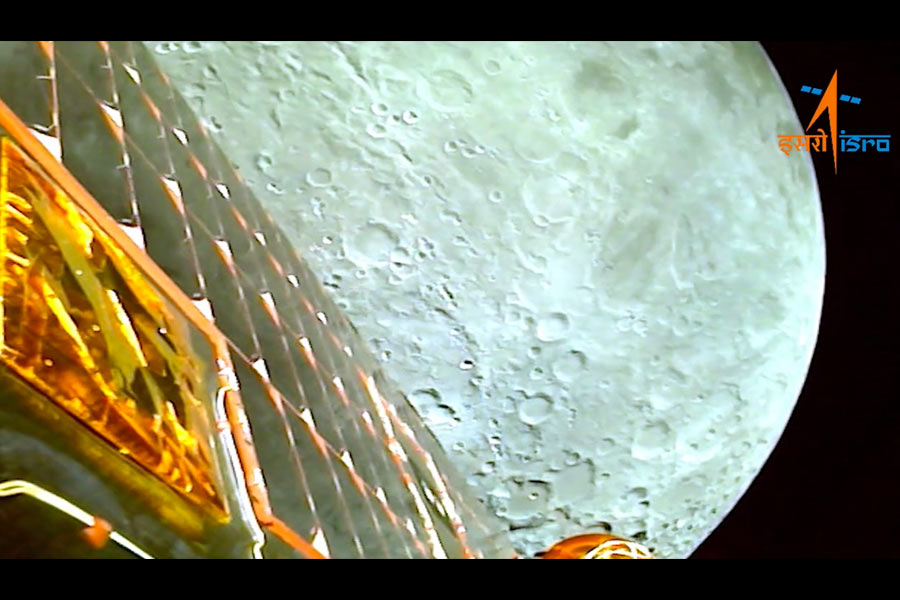India's ambitious third Moon mission's spacecraft Chandrayaan-3 on Monday underwent another maneuver, bringing it even closer to the Lunar surface, ISRO said.
The national space agency headquartered here said the spacecraft has now achieved a "near-circular orbit" around the moon.
Post its launch on July 14, Chandrayaan-3 entered into the lunar orbit on August 5, following which two orbit reduction maneuvers were carried out on August 6 and 9.
"Orbit circularisation phase commences. Precise maneuver performed today has achieved a near-circular orbit of 150 km x 177 km," ISRO said in a tweet.
The next operation is planned for August 16, around 8:30 am, it said.
As the mission progresses, a series of maneuvers is being conducted by ISRO to gradually reduce Chandrayaan-3's orbit and position it over the lunar poles.
According to ISRO sources, one more maneuver will be performed on the spacecraft on August 16 to reach 100 km orbit, following which the landing module, comprising the lander and rover will break away from the propulsion module.
After this, the lander is expected to undergo a "deboost" (the process of slowing down) and make a soft landing on the south polar region of the Moon on August 23.
Last week, ISRO Chairman S Somnath had said the most critical part of the landing is the process of bringing the velocity of the lander from 30 km height to the final landing, and that the ability to transfer the spacecraft from horizontal to vertical direction is the "trick we have to play" here.
He said, "the velocity at the starting of the landing process is almost 1.68 km per second, but this speed is horizontal to the surface of the moon. The Chandrayaan 3 here is tilted almost 90 degrees, it has to become vertical. So this whole process of turning from horizontal to vertical is a very interesting calculation mathematically. We have done a lot of simulations. It is here where we had the problem last time (Chandrayaan 2)." Further , it has to be ensured that fuel consumption is less, the distance calculation is correct, and all the algorithms are working properly.
"Extensive simulations have gone, guidance design have been changed, and a lot of algorithms have been put in place to make sure that in all these phases required dispersions are handled....to attempt to make a proper landing," he said.
Over five moves in the three weeks since the July 14 launch, ISRO had lifted the Chandrayaan-3 spacecraft into orbits farther and farther away from the Earth.
Then, on August 1 in a key maneuver -- a slingshot move -- the spacecraft was sent successfully towards the Moon from Earth's orbit. Following this trans-lunar injection, the Chandrayaan-3 spacecraft escaped from orbiting the Earth and began following a path that would take it to the vicinity of the moon.
Chandrayaan-3 is a follow-on mission to Chandrayaan-2 to demonstrate end-to-end capability in safe landing and roving on the lunar surface.
It comprises an indigenous propulsion module, lander module, and a rover with an objective of developing and demonstrating new technologies required for inter-planetary missions.
The propulsion module will carry the lander and rover configuration till 100 km lunar orbit. The propulsion module has Spectro-polarimetry of Habitable Planet Earth (SHAPE) payload to study the spectral and polarimetric measurements of earth from the lunar orbit.
The mission objectives of Chandrayaan-3 are to demonstrate safe and soft landing on the lunar surface, to demonstrate rover roving on the Moon, and to conduct in-situ scientific experiments.
The lander will have the capability to soft land at a specified lunar site and deploy the rover that will carry out in-situ chemical analysis of the Moon's surface during the course of its mobility.
The lander and the rover have scientific payloads to carry out experiments on the lunar surface.
Except for the headline, this story has not been edited by The Telegraph Online staff and has been published from a syndicated feed.











